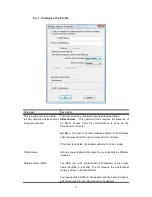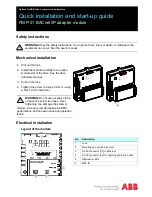
Parameter
Description
Channel
This setting is only available for Ad Hoc mode. Select the number
of the radio channel used for the networking. The channel setting
should be the same with the network you are connecting to.
Network Authentication
This setting has to be consistent with the wireless networks that
the adapter intends to connect. Note that in Windows Vista, the
adapter only supports Open System, Shared Key, WPA-PSK and
WPA2-PSK security methods.
Open System
– No authentication is needed among the wireless
network.
Shared Key
– Only wireless stations using a shared key (WEP
Key identified) are allowed to connecting each other.
WPA-PSK
– It is a special mode designed for home and small
business users who do not have access to network authentication
servers. In this mode, known as Pre-Shared Key, the user
manually enters the starting password in their access point or
gateway, as well as in each wireless stations in the network.
WPA-PSK takes over automatically from that point, keeping
unauthorized users that don’t have the matching password from
joining the network, while encrypting the data traveling between
authorized devices.
WPA2-PSK
– WPA2-PSK is also for home and small business.
The difference between WPA-PSK and WPA2-PSK is that WPA2-
PSK provides data encryption via the AES. In contrast, WPA-PSK
uses Temporal Key Integrity Protocol (TKIP).
WPA 802.1X
– WPA provides a scheme of mutual authentication
using either IEEE 802.1x/Extensible Authentication Protocol
(EAP) authentication or pre-shared key (PSK) technology. It
provides a high level of assurance to enterprises, small
businesses and home users that data will remain protected and
that only authorized users may access their networks. For
enterprises that have already deployed IEEE 802.1x
authentication, WPA offers the advantage of leveraging existing
authentication databases and infrastructure.
22
















































